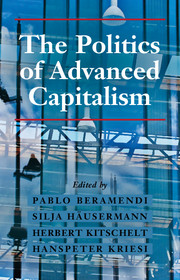Book contents
- Frontmatter
- Contents
- List of Figures
- List of Tables
- List of Contributors
- Preface
- 1 Introduction: The Politics of Advanced Capitalism
- PART I STRUCTURAL TRANSFORMATIONS
- Part II Politics
- 7 Party Alignments: Change and Continuity
- 8 What Do Voters Want? Dimensions and Configurations in Individual-Level Preferences and Party Choice
- 9 Trade Unions and the Future of Democratic Capitalism
- Part III Policies
- Part IV Outcomes
- Reference
- Index
9 - Trade Unions and the Future of Democratic Capitalism
from Part II - Politics
Published online by Cambridge University Press: 05 May 2015
- Frontmatter
- Contents
- List of Figures
- List of Tables
- List of Contributors
- Preface
- 1 Introduction: The Politics of Advanced Capitalism
- PART I STRUCTURAL TRANSFORMATIONS
- Part II Politics
- 7 Party Alignments: Change and Continuity
- 8 What Do Voters Want? Dimensions and Configurations in Individual-Level Preferences and Party Choice
- 9 Trade Unions and the Future of Democratic Capitalism
- Part III Policies
- Part IV Outcomes
- Reference
- Index
Summary
During the twentieth century, trade unions and employers' organizations had a firm place in modern market economies. Union organizations were the counterweight to business, striving to compensate for the vulnerability of the individual worker to the risks of the market. As economic and political organizations, trade unions could raise wages, improve working conditions, and promote center-left political parties, which represented their interests in the political arena. Social insurance and redistribution, employment protection, health and safety, and the expansion of the middle class over the last hundred years were directly connected to the presence of trade unions. Their organizations and functions emerged in the process of industrialization in the late nineteenth century parallel to employers' organizations.
From the vantage point of the second decade of the twenty-first century, twentieth century industrial organization has been undergoing tremendous change. These developments have impacted on political parties' and industrial interest associations' capacities to make and affect public policies and ultimately to affect economic outcomes, such as economic growth, unemployment, and inflation. Nevertheless, the stark cross-national diversity in industrial relations and political mobilization of labor, crystallized through long struggles, has not simply disappeared without a trace in contemporary postindustrial capitalism. Some critical elements linger on and separate in particular the Scandinavian from the Continental European polities, even though they are often combined under the rubric of “coordinated” market economies. These two, in turn, are still, in some ways, set apart from both the Anglo-Saxon liberal political economies, where the decline of organized labor has been most pronounced, as well as from the Mediterranean “mixed-market” capitalisms, with rather strong state intervention. As asserted in this book's introduction, there are common shocks and directions of change, albeit without entirely removing the cross-national diversity of industrial relations systems and their capacities to cope with the challenges of market allocation.
- Type
- Chapter
- Information
- The Politics of Advanced Capitalism , pp. 231 - 256Publisher: Cambridge University PressPrint publication year: 2015
- 20
- Cited by

